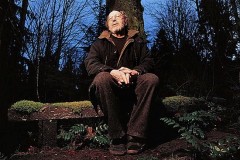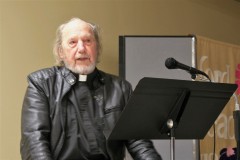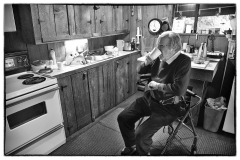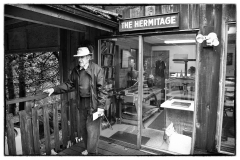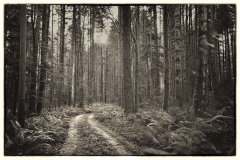Regional district staff recommend approving an amended application for groundwater extraction in Merville as a “home occupation,” but rural area directors want more clarity on its legal definition

Contemplation in action — a friend remembers Father Charles Brandt
Photo Caption
Contemplation in action — a friend remembers Father Charles Brandt
BY BRUCE WITZEL
Father Charles Brandt occasionally liked to quote his fellow monk Thich Nhat Hanh. The Buddhist teacher once was asked what we needed to do to save our world. “What we most need to do,” he replied, “is to hear within us the sounds of the Earth crying.”
How do we then respond to this call of the Earth’s cry, the people’s groaning? In this unprecedented moment of history — a worldwide pandemic coupled with increasing forest fires, floods, superstorms and mass migration of the Climate Emergency —doing nothing can no longer be an option.
Charles Brandt has left us many hints. His gifts and example of contemplation amidst action may well be an essential guide for us in echoing and raising our own voices.
“Where does contemplation lead one? Since it finds the Ground of Love in all reality, it leads to one’s sisters and brothers — it creates social consciousness, it leads to a deeper unity and love with and for the earth. Contemplation leads to transformation.” ~ Father Charles Brandt
It’s been two months now since Father Charles Brandt died — just three months ago, I last saw him alive. He was in good spirits as we sat on the porch of the hermitage overlooking his beloved Oyster River. “There is hardly a portion of her banks from the estuary to the snows that I have not travelled by foot,” he wrote in 1972. “Her music, her rhythm is a background to my life and work.” I was just a teenager then.
My father, Mac Witzel, befriended Charles upon his arrival to Vancouver Island in 1964. Or maybe it was the other way around. Charles had become a member of the newly formed Hermits of St. John the Baptist who lived alongside the Tsolum River. As we now know, not long afterwards the river was terribly poisoned by the copper mine up on Mount Washington.

Antelope Canyon, Utah | Father Charles Brandt photo
The group of hermits were quite poor and lived in roughhewn cabins — true to 60’s I think. Many local people were initially dubious of them, these non-conformists. Who were these monks struggling in the woods? Shouldn’t they pray in a monastery?
The hermits disbanded within a few years and most of them moved away. Charles was one of the exceptions. A wealthy benefactor helped Charles obtain 27 acres of land by the Oyster River which had been logged a couple of decades earlier.
His cabin was loaded onto a flatbed trailer and moved to its new site. My father was foreman of the local BC Highways Department and helped during the process. At one point the posts on the bridge across the Tsolum River blocked the cabin’s passage. They were cut shorter to let it through — “No one ever knew,” Charles later admitted.
~~~~
During those years as a youngster, I barely saw or knew of Fr. Charles Brandt. He was a hermit after-all. Our friendship really began years later during the 1980s at a weekend meditation retreat that he led on Spirituality and the Environment.
“Follow your bliss” he said while conveying the comparative religious thought of Joseph Campbell. In explaining deep ecology, social ecology, integral ecology and cosmology Fr. Charles spoke about Fritjof Capra, Simone Weil, Thomas Berry and Brian Swimme.
The retreat eventually helped me to make a decision to leave my well-paying job on the booms of the Port Alice pulp mill. For eight months I went to live and work with the poor in the mountains of Mexico. “What can privileged people do to help?” I asked the local Padre. “First, pray,” he said. “Secondly, don’t use more than you need to — thirdly, defend the human rights of the poor.”
Work was at the base community level with campesino farmers, health workers, and other local organizers. We discussed Liberation Theology during training workshops about helping with people’s nutritional needs or even pouring concrete together. We promoted alternative methods of cooking by building solar ovens or efficient “rocket stoves” with local carpenters.
According to the World Health Organization an estimated 2.4 billion people, generally among the world’s poorest, rely on biomass like wood or dung for their heating or cooking needs. Solid fuel dependency exacerbates deforestation and climate change. Breathing interior smoke is responsible for the deaths of an estimated 1.6 million people annually. More than half of these deaths occur among children under five years of age.
~~~~
 Over the next 30 years I cherished occasional visits with Charles when I travelled to Comox Valley. My wife Francis once said to me when I was feeling down, “why don’t you call Charles?” Another time he described to me verbatim, the Buddhist eight-fold path. This was the essence of Charles Brandt —clearheaded sage wisdom magnified by his caring soul and quiet calm presence.
Over the next 30 years I cherished occasional visits with Charles when I travelled to Comox Valley. My wife Francis once said to me when I was feeling down, “why don’t you call Charles?” Another time he described to me verbatim, the Buddhist eight-fold path. This was the essence of Charles Brandt —clearheaded sage wisdom magnified by his caring soul and quiet calm presence.
Charles loved the world and its creatures. He was an expert birder and had assisted setting up the renowned bird recording lab at Cornell University in the late 1940s. He believed that the poor and disparaged of the earth included all these creatures and we need to reaffirm the dignity of the poor, human and non-human.
The strong connection Charles made with many people who knew and loved him was this — a common care for the earth and its people — oneness with the Sacramental Commons, as Charles put it. Yet in spite of this steadfast believe and his gentleness, Charles was never one to suffer fools gladly. Although he rarely displayed it, his critique could be quick and sharp. His vocation was clearly prophetic — somewhat like his mentor the Trappist monk Thomas Merton, who once wrote — “Nothing has ever been said about God that hasn’t already been said better by the wind in the pine trees.”
Such was the person of Father Charles Brandt.
~~~~
Now on that crisp fall September day a few months ago, here I was sitting with Father Charles and a mutual friend, Willa Cannon. As a retired nurse, Willa with her husband Jim helped Charles in a myriad of ways. Their earlier work together with the Tsolum River Restoration Society had bonded their goodwill.
The annual meeting of the Brandt Oyster River Hermitage Society had been delayed for months because of COVID 19 protocols. Though we had the support of at least a dozen friends, Charles called for the meeting to be small — only three of us. We began with making clarifications about the direction of the Society. Charles wanted to put more emphasis on contemplative prayer and he spoke of the need to be conscious that “Only the Sense of the Sacred can Save Us.”
It was agreed to add this to our vision. It follows as thus:
The Brandt Oyster River Hermitage Society seeks to fulfil the explicit wishes of Father Charles Brandt, that: The forest and house of the Hermitage is to be preserved as a peaceful centre for contemplating the spiritual foundations of ecology and nature as a sacred commons, and as a home for a designated Catholic hermit or other contemplative person dedicated to the environment and a life of contemplative prayer, who shares this vision.
The human community and the natural world will go forward into the future as a single sacred community or we will perish in the desert. Only the sense of the sacred can save us.
~~~~
We then briefly discussed the land conservancy for the forest and hermitage that had been put in place with the Comox Valley Land Trust in January 2019. In this regards, Charles expressed his gratitude for the work of two of our early directors, biologists Kathryn Jones and Loys Maingon. Then Charles affirmed the person called to be the new contemplative resident at the hermitage — Karen Nichols, a Benedictine Oblate.
Charles told us how Karen had helped years before archiving the library of Bernard de Aguiar upon his death. Bernard had been an assistant to Thomas Merton before becoming one of the original Hermits of St. John. He later became a potter on Hornby Island. Karen’s mother had been a conservationist and passed that value onto her. Her mandate will be to archive Charles’ extensive files and continue on — in Karen’s words — for the hermitage to be “a place of prayer and meditation and of conservation awareness”.
As our meeting closed Charles reached across the table to shake my hand. I reminded him we weren’t supposed to. He grinned and attempted an elbow bump but the table blocked us. With folded hands, I bowed to Charles, and then he to me. Without a word, each of us knew — the Sacred in me recognizes the Sacred in you.
These were my final moments with frater Charles A.E. Brandt.
~~~~
Only 10 days later Charles fell at the hermitage. He emailed people for help, if you can imagine that. A neighbour came over along with another friend who is a retired doctor, Bruce Wood. During many of Charles’ last 19 days in the hospital, Willa Cannon was often with him. Not long before losing consciousness he reached out and took Willa’s little hands and engulfed them with-in his. The last embrace of a dying man — he gave of himself, as always. Father Charles Brandt was true to his Christian faith to the last.
Bruce Witzel wrote this article on behalf of the Brandt Oyster River Hermitage Society in the hope to continue on with the work and gifts Charles has left us. He is a co-director and chairperson of the society.
FATHER CHARLES OYSTER RIVER HERMITAGE LANDS PROTECTED WITH COVENANT
The Comox Valley Land Trust (CVLT) holds a conservation covenant over 27-acres of wild land on the banks of the Oyster River. The land was the home of spiritual leader and conservationist Father Charles Brandt, 95, who asked the CVLT to protect the mature forest and riparian areas for future generations. Father Charles died earlier this fall.

Father Charles Brandt, or “Father Charles,” had lived in his hermitage on the 27-acres bordering the Oyster River since 1970. As the first ordained Catholic priest-hermit in two centuries, he asked the CVLT to hold conservation covenant over the property to safeguard the values of conservation and ecological stewardship.
“The covenant will ensure that these mature forests and riparian areas, as well as the plants and wildlife that call them home, are protected for future generations in perpetuity,” says Tim Ennis, executive director of CVLT.
“We must fall in love with the Earth, and we only save what we love,” says Father Charles. “It is my deep love of contemplation and communion with the natural world that has led me to act in its defense.”
Funding required to complete the project was generously provided by Judy Hager (in memory of Bob Hager), the Oyster River Enhancement Society, members of the Tsolum River Restoration Society, and other local community members.
— adapted from the Comox Valley Lands Trust website
SUBSCRIBE TO OUR NEWSLETTER
On Merville groundwater extraction it’s deja vu all over again
Merville water bottling issue returns to the CVRD, highlights provincial water policies
The Comox Valley Electoral Areas Service Commission will consider on Monday an amended application for water bottling operations in Merville and draw attention to larger water policy issues in British Columbia
What’s dire: the lack of Comox subdivisions or climate change and gradual deforestation?
A Comox Valley developer is suing the Town of Comox because his permits to cut down trees and build more single-family homes haven’t been issued as fast as he’s wanted and because the town wants a wider walking trail through the property
Join the discussion Oct. 3 about food system security in the Comox Valley
The Watershed Sentinel magazine is hosting a zoom webinar Oct. 3 on food system security in the Comox Valley
Comox Valley Nature webinar to discuss effect of climate change on marine life
Comox Valley Nature lecture to discuss how this summer’s heatwave killed off billions of sea life and the future for marine ecosystems
New North Island organics processing facility raises concerns about cost, fire and odours
Campbell River environmentalists raise concerns about the the cost and location of the Comox Strathcona Waste Management Commission’s new organics processing facility
THE WEEK: 5 things wrong with how Comox tried to hide sewage spill information
Comox Town Council has nothing to say about raw sewage leaking into Brooklyn Creek beyond issuing a press release, which makes misleading statements
Tonnes of sewage mud removed from Brooklyn Creek, nearby residents say its been piling up for years
A Town of Comox infrastructure failure could have spilled raw sewage into Brooklyn Creek for a long time, according to nearby residents who have noticed unusual plant growth and sewage-type odours for nearly 24 months. Mayor and councilors say they didn’t know about it
Town of Comox spills raw sewage into Brooklyn Creek, doesn’t inform public
A broken pipe has spilled raw sewage into Brooklyn Creek and it appears that efforts to mitigate the damage have created a high level of turbidity, a double whammy for fish as well as a potential public health concern. But the Town of Comox has not yet formally informed the public.
Campbell River Environmental Committee lists its current top priorities
The Campbell River Environmental Committee has kept North Island residents aware of environmental risks and promoted awareness of potential concerns to help government and industry make informed decisions


